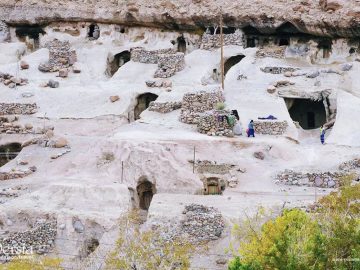
Meymand village is located in southeast of Iran and in central district of Babak county in Kerman province. The village is at an altitude of 2,240 meters above sea level in a 420 km2 area that displays the interaction of human and nature.
The weather of Meymand mountains is moderate and there are two springs and two Qantas watering the village. Natural features lead to the structure of Meymand rocky village. Beside this natural feature, the remoteness of the place, its ruggedness and the fact that it overlooks the hills, turned it into a suitable place to build a village that its location provides all the defense it needs. The basis for the form of architecture used in this village goes back to an ancient culture that specified mountains as sacred parts of nature and emphasized respect of elements. In this culture, mountains are the place of Gods like Mithra, the God of covenant.
The village was registered by UNESCO as a World Heritage in 2015.
Estimating when the village was created is a very difficult job, many researches have been done and many theories were made in this regard. Some believe that it was made in seventh and eighth century BC because Medes made several rocky monuments in the east of Iran and Mithraism was a common religion at the same time. Others attribute it to the end of Parthian dynasty and early Sassanid period. The second theory seems more probable because archeologists discovered potteries from the citadels and cemeteries around the village that were similar to those found in cities like Babak, Kerman and Sirjan that belonged to Sassanid era.
This village consists of more than 400 rocky houses that were made in mountains with a spiral shape in four or five stories. The yard of each house is the roof of the other house located in a lower level. In front of each house, there is a large bulge that is named Toql, a place like a terrace for sitting and spreading dried fruits. The residence place is about 2 meters high and with the areaof 7 to 25 m2. The internal spaces are square, rectangle, round and some have erratic shapes with wooden short entrances each 1.5 or 1.6-meter tall. Next to the entrance, in the wall, there is a hole with an object named kelidoon that through it the door is opened or closed. The most interesting sections of the village are as follows:
The Fire Temple
A place used like a temple to worship the Mehr and after Zoroastrianism it has been turned to a fire temple.
The Bathroom
It is located in the lowest surface than other places and next to the river where the water came from and then disposed. The bathroom consists of three sections including an internal space, locker space and heating area.
Kicheh
The valleys of the village are known as Kicheh. Each Kicheh is about 1 to 2.5 meters wide and links the houses to each other. The structures of Kicheh have been made with accurate calculations and not by chance.
The Corridor
It is the main section of a neighborhood used for cooking foods and baking bread.
The school
A small area used as the cultural center of Meymand village. It used to be a manor house that was donated and turned into a school. Due to the increasing population of the village a new school was built and the old school turned into the cultural center.
The cemetery
Like any other city or village, the residents used a place far from their living area as the cemetery. It is located in the southern region of the village and the tombstones were designed with the name of God, prophet and Shiite Imams. Some of the larger tombs had animal motifs as well.
The Hosayniya
It is located in the center of village and consists of three short arched halls (iwan). It was created by the combination of several residential places and in an irregular form. It is about 200 m2 with four stony pillars about 1.80 to 2-meters high. The pillars are what keep the Hosayniya stable. In the past a stony pulpit was attached to the first column that has been destroyed and replaced with a wooden pulpit.
The mosque
It was made by combining several residential places. The mosque is about 120 m2 and has a round and irregular form. The roof of the mosque is placed over three stony columns, each 2 meters tall. The entrance gate of the mosque is the only way to the outside and the sole provider of natural light.
What makes the village unique is that it is the only rocky village of the world that is still active and in the other words people are still living there.
The village was registered by UNESCO as a World Heritage in 2015.


